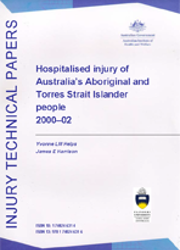Summary
The report provides a cross-sectional summary of hospital separations due to injury and poisoning for the aggregated data collection periods 2000–01, and 2001–02 for Australia’s Aboriginal and Torres Strait Islander people. The report text respectfully refers to people identifying as being Aboriginal, Torres Strait Islander or Aboriginal and Torres Strait Islander collectively as Indigenous, in light of space restrictions in tables, and in the interests of readability. Aboriginal and Torres Strait Islander is our preferred term, and is used for all table and chart headings.
Ascertainment of Indigenous data in hospital records differs in quality between jurisdictions, and over different time periods. Data for whole of Australia is presented as a population overview. This report focuses on a region consisting of grouped jurisdictions of better quality Indigenous ascertainment in hospital separations data, referred to as Region A (comprising the Northern Territory, South Australia, Western Australia and Queensland). Comparison of case numbers and rates of separations across total External causes and six selected External causes are made against data for non- Indigenous Australians in the same grouped jurisdictions. Corresponding data for the grouped jurisdictions (referred to as Region B) of less reliable reporting quality are included in the Appendix.
For Region A, Assault was the most common reason for a hospital stay for Indigenous persons, followed by Falls, Transport, Self-harm, Burns and Poisoning by pharmaceuticals. More Indigenous females were affected by Assault and Self-harm than Indigenous males, and more Indigenous males were injured in Transport accidents than Indigenous females. In Region A the rate ratio of Indigenous to non-Indigenous hospitalisation for Assault for females was nearly 46:1, and for males, 10:1. The rate for female Indigenous Self-harm was nearly double the rate for non-Indigenous females, and the rate for Indigenous males was over twice that for non-Indigenous males. Fires, burns and scalds caused hospitalisation for Indigenous females four times more often than for non-Indigenous females, and for Indigenous males, three and a half times more often than non-Indigenous males.
Indigenous Australians are more likely than other Australians to live in remote areas, and rates of external cause injury generally rose with degree of remoteness of residence, rates for Indigenous Australians were commonly higher than rates for non-Indigenous Australians, and rates for Indigenous males were generally higher than rates for Indigenous females. Differences specific to the selected external cause groups are noted in separate sections.
Average length of hospital stay was highest for Burns (9.6 days), followed by Transport cases (5.3 days), Falls (3.5 days), Assault (2.8 days), Self-harm (2.5 days) and Poisoning by pharmaceuticals (2.0 days).
It is well known that the standard of health of Australia’s Indigenous people is substantially lower than that of other Australians. The report identifies a number of differences between Indigenous and other Australians in a range of external causes of injury, not all of which are accounted for when methods of standardisation are applied to factors such as age, population size and remoteness of area of residence. Prevention and control are areas in which improvement can be made to reduce the outstanding differences between Indigenous and non-Indigenous experience of injury. Room for improvement in quality of Indigenous ascertainment in hospital data exists in Region A as well as the remaining jurisdictions.



